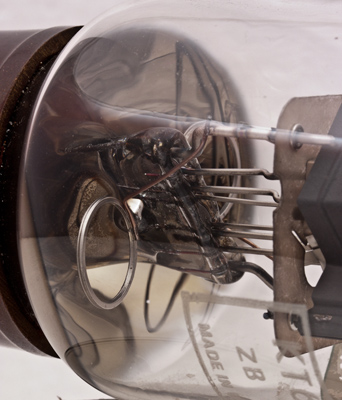|
KT66Sensibly equivalent¶ to:See also:
|
|
|

|
The KT66, originally given the Type code N66, is a very well known audio output beam tetrode valve. Our exhibit is a post-WWII device, probably dating from the 1970s, as from the 1970s the KT66 lacked the internal carbon dust coating of the glass bulb that can be seen in KT66. In the 1950s the production used black base caps and pre-WWII had the classic envelope shape.In 1952 the KT66 was advertised as the finest audio tube in the world.
The anode side view, through the holes can be seen the bright beam forming plates.The KT66 was essentially a 6L6 redesigned with a larger cathode and a shorter, fatter anode. The KT66 had less rapid acceleration, longer electron paths, and almost no kink. It was ace for audio hi-fi but the electrons took longer to reach the anode and were more open to influence from magnetic, etc, fields on the way. Moreover, under HF conditions the electron stream was not perfectly in phase with the grid signal and this resulted in a loss of output power if used for RF applications.The figures given are for single ended use, but a pair run in ultra linear AB2 push pull will deliver 50 Watts with 2% distortion.
The base of the valve showing the rectangular section cathode tube and copper control grid support rods complete with notches. The screen grid supports can be seen to be within the right angle of the beam forming plates.
The pinch and getter support ring.
The top mica showing the control grid cooling fins. In the centre the folded heater can be seen within the cathode tube.
The carbonised anode, cooling flange and fixing to support rod.
It is not uncommon to find these valves used in parallel push pull. Here each single valve of the push pull pair is replaced with two valves connected in parallel. A 100 W amplifier results.The shape of the envelope is a mixture of the classic shape and the wide tube. Due to the metallisation on the inner of the envelope the electrode structure is obscured.The EL37 is not a direct equivalent and neither is the 6L6. The EL37 has a high value of gm of 11.0 mA/V and the 6L6 has a value 5.2 mA/VThe classic envelope is 48 mm in diameter and, excluding the IO base pins, is 113 mm tall.References: Data-sheet, 1004, 1005 & 1040. Type KT66 was first introduced in 1937. See also 1937 adverts. |
Pin Connections
| 1 | 2 | 3 | 4 | 5 | 6 | 7 | 8 |  m | h | a | g2 | g1 | nc | h | k,bp |
|
|
Absolute Maximum Operating Conditions¶
| Vh | Ah | Va | Vs | Vg | mAa | mAs | ra | gm | Pout | D | 
| 6.3 | 1.27 | 250 | 250 | -15 | 85 | 6.3 | 22.5k | 6.3 | 7.25 | 9% |
|
Updated January 13, 2024.
|
|